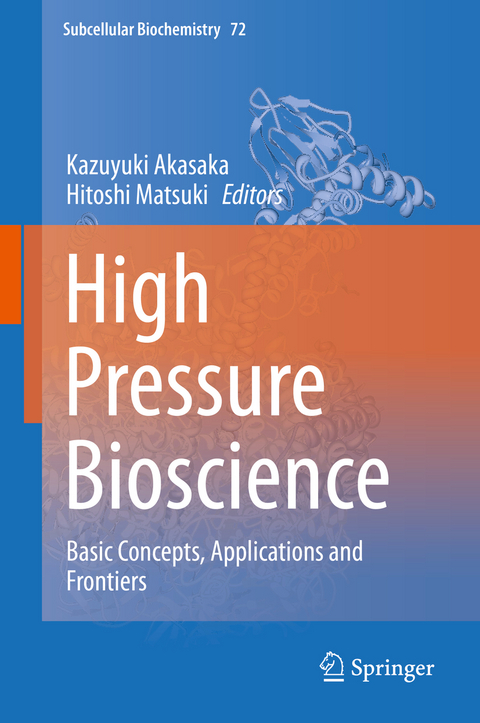
High Pressure Bioscience
Springer (Verlag)
978-94-017-9917-1 (ISBN)
This book serves as a valuable resource not only for those working directly in a pressure-related field, but also for those working in many other fields of the biosciences. Particularly, the basic part of it is intended to serve as a classical text book on high-pressure bioscience to a wide audience including students and researchers in both basic and applied fields in years to come. Readers can focus on topics of immediate interest first, but may wish to go over other chapters if interest arises in a later occasion.
Part I Why and How Proteins Denature under Pressure?.- 1 Early Days of Pressure Denaturation Studies of Proteins.- 2 Protein Denaturation on p-T Axes - Thermodynamics and Analysis.- 3 Driving Forces in Pressure-induced Protein Transitions.- 4 Why and How Does Pressure Unfold Proteins?.- Part II Volume, Compressibility, Fluctuation and Interaction in Proteins.- 5 Volume and Compressibility of Proteins.- 6 Pressure-Dependent Conformation and Fluctuation in Folded Protein Molecules.- 7 Water Turns the "Non-Biological" Fluctuation of Protein into "Biological" One.- 8 Pressure Effects on the Intermolecular Interaction Potential of Condensed Protein Solutions.- Part III Pressure and Functional Sub-States in Proteins.- 9 High Pressure NMR Methods for Characterizing Functional Sub-States of Proteins.- 10 High-Pressure NMR Spectroscopy Reveals Functional Sub-States of Ubiquitin and Ubiquitin-Like Proteins.- 11 Functional Sub-States of Proteins by Macromolecular Crystallography.- 12 Cavities and Excited States in Proteins.- Part IV Pressure and Protein Folding and Assembly.- 13 Exploring the Protein Folding Pathway with High-Pressure NMR: Steady-State and Kinetic Studies.- 14 Basic Equations in Statics and Kinetics of Protein Polymerization and the Mechanism of the Formation and Dissociation of Amyloid Fibrils Revealed by Pressure Perturbation.- 15 Pressure-Inactivated Virus: a Promising Alternative for Vaccine Production.- Part V Pressure Effects on Biological Membranes.- 16 How Do Membranes Respond to Pressure?.- 17 Pressure Effects on Artificial and Cellular Membranes.- 18 Effects of High Hydrostatic Pressure on Microbial Cell Membranes: Structural and Functional Perspectives.- 19 Homeoviscous Adaptation of Membranes in Archaea.- Part VI Pressure adaptation and tolerance of proteins and living organisms.- 20 Pressure-Dependent Gene Activation in Yeast Cells.- 21Environmental Adaptation of Dihydrofolate Reductase from Deep-Sea Bacteria.- 22 Moss Spores Can Tolerate Ultra-High Pressure.- Part VII High pressure food processing and pasteurization.- 23 Pressure-Based Strategy for the Inactivation of Spores.- 24 Use of Pressure Activation in Food Quality Improvement.- 25 Use of Pressure for Improving Storage Quality of Fresh-Cut Produce.- 26 Application of High-Pressure Treatment to Enhancement of Functional Components in Agricultural Products and Development of Sterilized Foods.- Part VIII Pressure Effects on Motility, Physiology and Health.- 27 High-Pressure Microscopy for Studying Molecular Motor.- 28 Ion Channels Activated by Mechanical Forces in Bacterial and Eukaryotic Cells.- 29 Gravitational Effects on Human Physiology.- Part IX Methodology.- 30 High Pressure Small-Angle X-Ray Scattering.- 31 High Pressure Macromolecular Crystallography.- 32 High-Pressure Fluorescence Spectroscopy up to 700 MPa.- 33 High Pressure NMR Spectroscopy.
| Reihe/Serie | Subcellular Biochemistry ; 72 |
|---|---|
| Zusatzinfo | 155 Illustrations, color; 109 Illustrations, black and white; XVII, 730 p. 264 illus., 155 illus. in color. |
| Verlagsort | Dordrecht |
| Sprache | englisch |
| Maße | 155 x 235 mm |
| Themenwelt | Medizin / Pharmazie ► Studium |
| Naturwissenschaften ► Biologie ► Biochemie | |
| Naturwissenschaften ► Biologie ► Mikrobiologie / Immunologie | |
| Naturwissenschaften ► Chemie ► Physikalische Chemie | |
| Naturwissenschaften ► Physik / Astronomie ► Angewandte Physik | |
| Technik ► Umwelttechnik / Biotechnologie | |
| Schlagworte | Fundamental Pressure Effects on Protein Structure and Dynamic • High Pressure Methodology in Life Science • Mechanical Stress Effects in Physiology • Pressure Adaptation in Membranes and Organisms • Pressure in Food Processing |
| ISBN-10 | 94-017-9917-2 / 9401799172 |
| ISBN-13 | 978-94-017-9917-1 / 9789401799171 |
| Zustand | Neuware |
| Haben Sie eine Frage zum Produkt? |
aus dem Bereich


